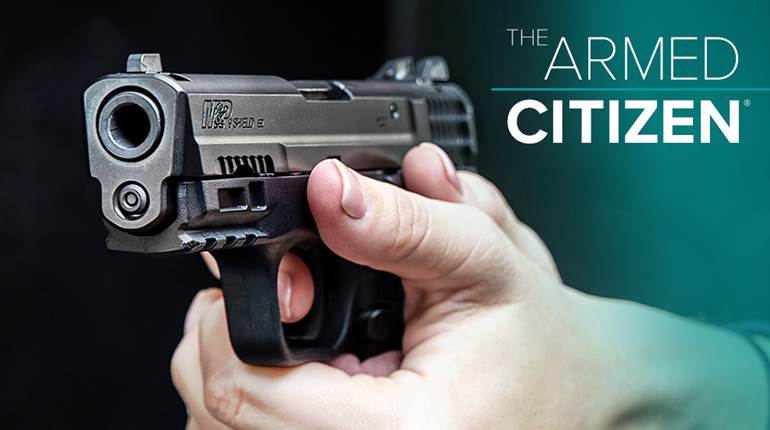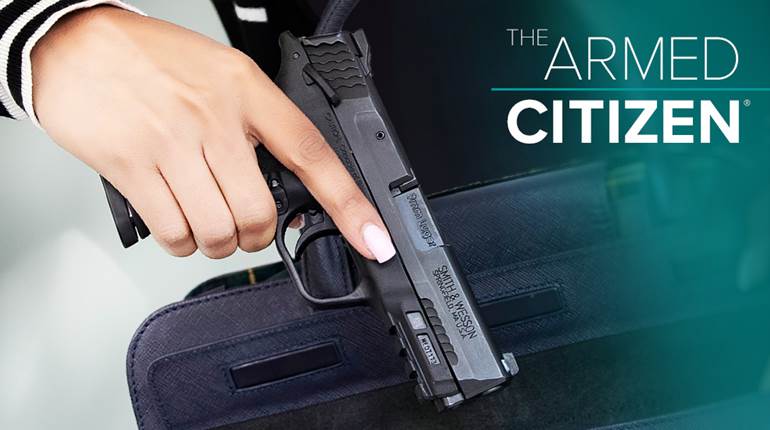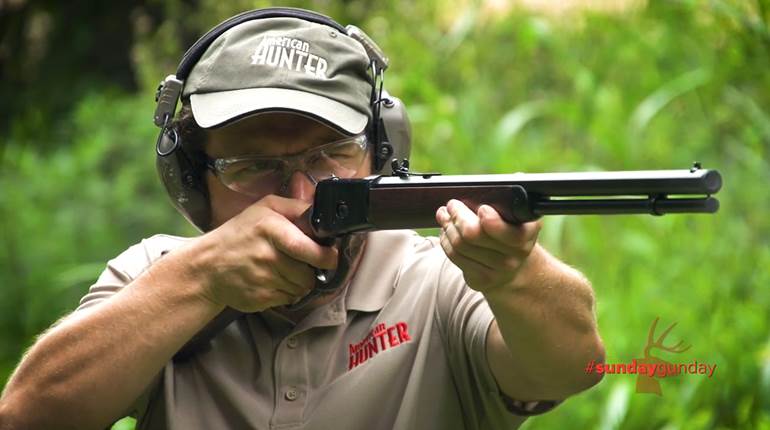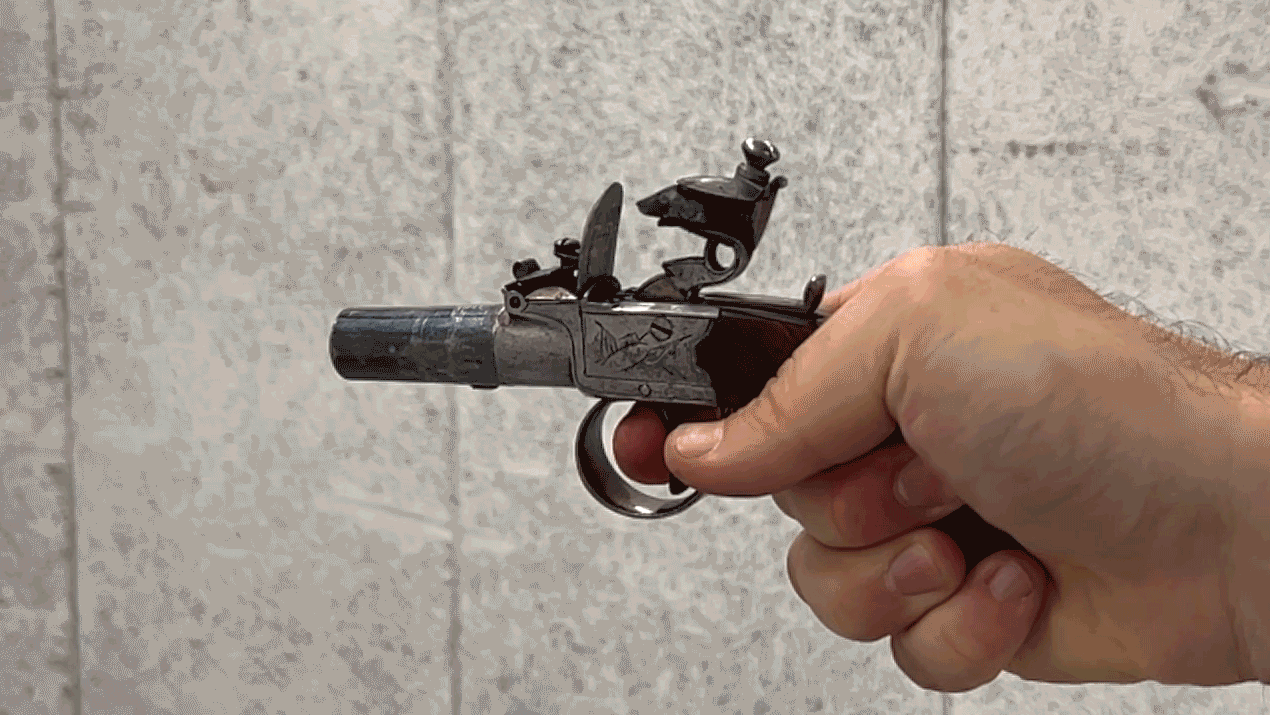
Today, the concept of small, pocketable, personal-defense guns is widely accepted and well supported. Those looking for one are spoiled for choice, with dozens of small, easily carried options on the market. But the concept of a compact, pocket-size self-defense pistol is also an old idea. It goes back hundreds of years, even into the 17th century, and it reinforces the fact that firearms designed solely for self-defense by vigilant armed citizens have been around for a long time. Case in point: the flintlock pocket pistol of the George III era. These single-shot pistols are also commonly known as a “turn-off” pistol or a “muff” pistol, the latter name emerging due to the fact that it could be easily concealed in a lady’s “muff,” a cylinder of fur or fabric designed to keep hands warm.

The origin of the turn-off pistol concept harkens back to the reign of Queen Anne, when guns were first developed with barrels that threaded onto the breech for easy loading. In fact, they were likely developed earlier, in the latter decades of the 17th century, but by the time of Queen Anne, they were in common enough use to warrant the descriptor still attached to them today, that of the “Queen Anne pistol.” Early designs were sized similarly to the flintlock horse pistols of the day, having barrels in the 9” to 12” range, though some smaller models were also produced.

At its heart, the concept of a turn-off pistol was simply that the barrel was screwed to the breech and was designed to be removed with a barrel key, which allowed the gun to be loaded at the breech end, not from the muzzle with a ramrod as was the practice with traditional flintlock pistols of the era. Using the supplied key, which locked into a lug attached to the barrel, the user simply unscrewed the barrel from the breech, revealing a powder chamber and a concave surface that matched the caliber of ball used in the pistol. To load the gun, one simply filled the powder chamber until the powder was flush with the bottom of the concave ball surface, then set the ball into the concave breechface. Then the barrel would be threaded back on, and the key used to turn the barrel back down onto the breech until tight.
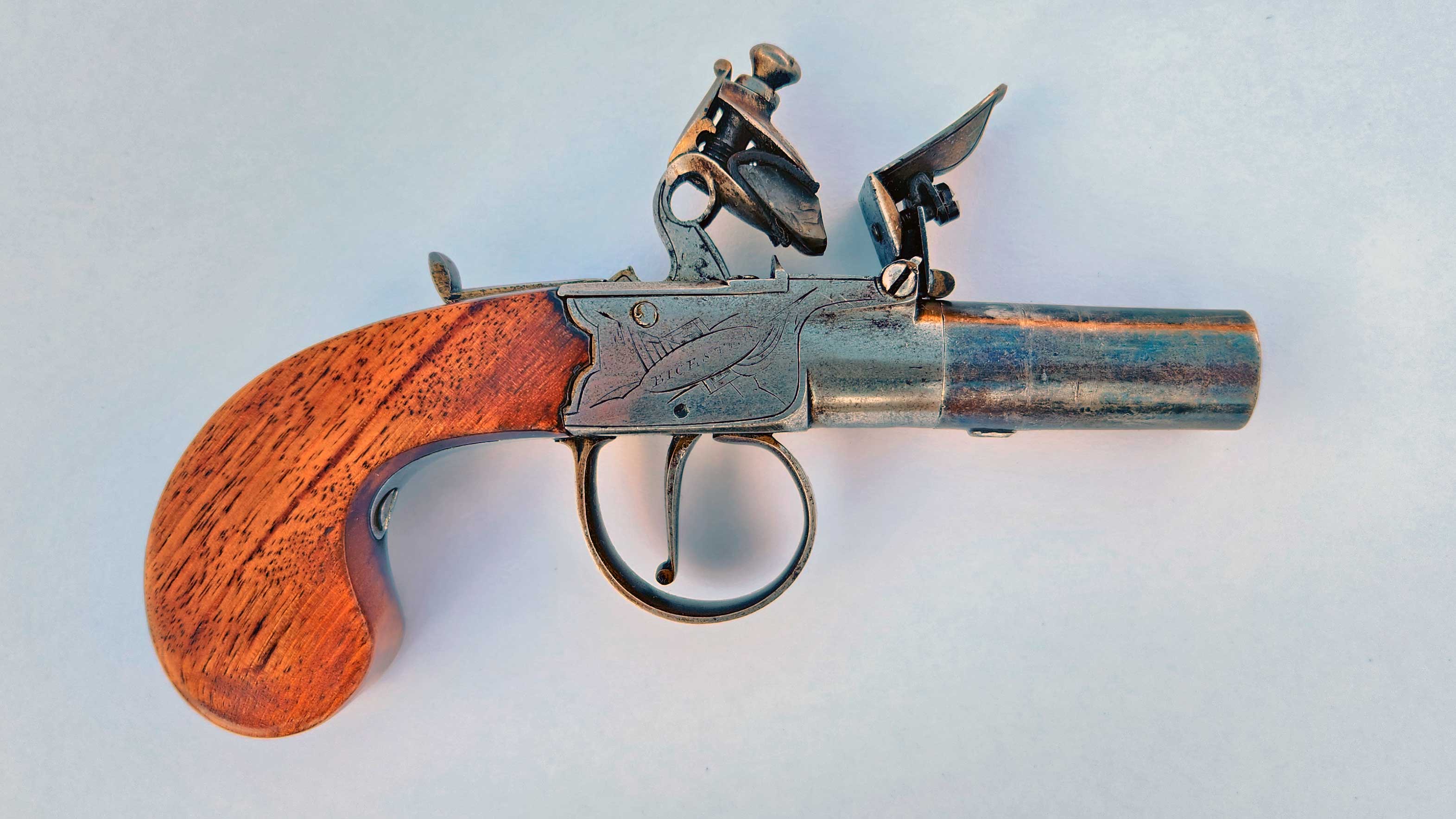
A benefit of the screw-off system was that round balls slightly oversize could be placed into the breech and then would be swaged down as the barrel was turned back onto the breech, thereby providing a tight fit. Not only would this ensure that ball and barrel remained in the gun as the loaded pistol was carried barrel-down, but the tight fit enabled pressure to build up behind a fired ball, adding extra velocity and energy to the moving projectile compared to one that had been sized down from having been loaded at the breech.

As the 18th century developed, larger Queen Anne-style gun were downsized until they reached truly pocketable proportions. This particular example, made by William Ball of Bicester in Lincolnshire, England, is a typical example of its type, having a single .49-cal. smoothbore barrel with a centrally mounted flintlock ignition system. The bright-finished boxlock frame is engraved on right and left sides with a crossed-flag motif, transitioning to a circular breech onto which the blued 1.75” barrel is threaded. At the bottom of the gun’s frame is a straight trigger with a scroll flourish at its bottom edge, protected by a circular trigger guard. At the top, a centrally mounted hammer (cock), priming pan and frizzen sit above the breech. A well-preserved, flat-sided walnut grip curves downward into a rounded butt. The barrel includes a well-worn lug on its bottom face, which allows the original key, now long gone, to turn the barrel off the boxlock frame. A set of post-1812 Birmingham proofs are found on the underside of the breech. Ball was known to have produced guns from 1810-1816, and this particular gun fits squarely within that time period.
 This particular flintlock pistol, attributed to William Ball of Bicester, England, bears post-1812 Birmingham proof marks. Since Ball is known to have produced these pistols up to 1816, this narrows down the date range for this particular gun to just a few years in the beginning of the 19th century.
This particular flintlock pistol, attributed to William Ball of Bicester, England, bears post-1812 Birmingham proof marks. Since Ball is known to have produced these pistols up to 1816, this narrows down the date range for this particular gun to just a few years in the beginning of the 19th century.
An additional feature of the design, commonly seen on guns produced in the latter portion of the 18th century and beyond, is the addition of a sliding safety lever located on the rear of the receiver tang. After the gun is loaded and primed, the hammer is moved to half-cock, and then the sliding safety can be engaged. When the safety is on, the trigger and cock are immobilized. In the era, pistols of this type were carried within a pocket, not a holster, so the safety prevented the hammer from being fully cocked and creating a potential safety hazard within the pocket of an armed gentleman or lady. It’s indisputable proof that these kinds of guns were designed and built to be loaded and carried as defensive tools.
 A sliding safety at the rear of the boxlock action's tang can only be engaged when the hammer is at half-cock. Once engaged, the hammer is immobilized, preventing the gun from going to full-cock inside of a pocket.
A sliding safety at the rear of the boxlock action's tang can only be engaged when the hammer is at half-cock. Once engaged, the hammer is immobilized, preventing the gun from going to full-cock inside of a pocket.
As a defensive tool, there’s not much to recommend the muff pistol other than the fact that it’s easy to carry. When loaded with a .50-cal. ball, the .49-cal. barrel will allow the projectile to swage slightly, giving it some added velocity due to the pressure build-up behind the ball, but given the pistol’s scant 1.75” barrel and the comparatively low energy provided by the propellant charge of 25 grains of blackpowder, the muzzle energy of a fired round comes out to about 100 ft.-lbs. Comparatively speaking, that’s about the same amount of energy expected from a modern-day 40-grain .22 LR round fired from a 4.25” handgun barrel. Also worth noting is that this pocket pistol was designed to be fired exactly once in a potential defensive scenario. Given the necessary tools and multi-component loading process, one was not going to reload on the fly.

Given the design of these boxlock pistols, it’d have to be a pretty close-quarters defensive scenario to make that one shot count. Considering the location of the top-mounted flintlock priming mechanism, these guns do not have sights. Aiming is largely a “pointing” proposition. In our live-fire testing of this particular pocket pistol, hoping to hit anything larger than a man-size torso at more than 3 yards was dicey. Ignition was surprisingly quick and reliable, and the flintlock mechanism on this more-than-200-year-old self-defense pistol still works like a charm.
 A narrow powder chamber holds about 25 grains of FFG blackpowder, which is enough to propel a .50-cal. round ball out at a modest velocity. The concave surface ahead of the powder chamber is designed to allow the ball to seat. A wrench can be used to turn the barrel back onto the action.
A narrow powder chamber holds about 25 grains of FFG blackpowder, which is enough to propel a .50-cal. round ball out at a modest velocity. The concave surface ahead of the powder chamber is designed to allow the ball to seat. A wrench can be used to turn the barrel back onto the action.
In the heyday of the flintlock pocket pistol, huge numbers were produced in a range of different sizes, calibers and designs. A popular variation on the design featured a fold-out trigger that only exposed itself once the hammer was fully cocked. Multi-barrel designs were known, as were guns that had significantly longer barrels. Often, these boxlock pocket pistols are encountered as a cased set, providing the discerning gentleman with a backup option in the way of a second gun.
As the flintlock mechanism gave way to percussion priming, many of these small, single-shot pistols were converted to percussion or built exclusively as percussion-primed guns. Only when multi-shot pepperboxes and revolvers began to emerge in the 1830s and 1840s did the single-shot self-defense pistol begin to fall by the wayside. Even through the Civil War, though, single-shot "boot" pistols were still seen frequently, and only the advent of the metallic-cartridge era saw the end of these style of arms.
Today, these guns are encountered fairly regularly, testifying to the fact that they were widely produced. Collectors will encounter a range of values that often have to do as much with the maker’s name as with the condition of the gun. This particular pocket pistol, though well-made, was not produced by a top maker and therefore does not command the premium price that accompanies some of the London-made examples. It still retains a fair amount of bluing on its barrel, but much of its engraving has been worn away. In NRA Very Good Condition (Antique), this gun is worth between $400 and $600.













